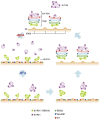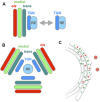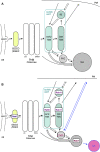The Golgi Apparatus and its Next-Door Neighbors
- PMID: 35573670
- PMCID: PMC9096111
- DOI: 10.3389/fcell.2022.884360
The Golgi Apparatus and its Next-Door Neighbors
Abstract
The Golgi apparatus represents a central compartment of membrane traffic. Its apparent architecture, however, differs considerably among species, from unstacked and scattered cisternae in the budding yeast Saccharomyces cerevisiae to beautiful ministacks in plants and further to gigantic ribbon structures typically seen in mammals. Considering the well-conserved functions of the Golgi, its fundamental structure must have been optimized despite seemingly different architectures. In addition to the core layers of cisternae, the Golgi is usually accompanied by next-door compartments on its cis and trans sides. The trans-Golgi network (TGN) can be now considered as a compartment independent from the Golgi stack. On the cis side, the intermediate compartment between the ER and the Golgi (ERGIC) has been known in mammalian cells, and its functional equivalent is now suggested for yeast and plant cells. High-resolution live imaging is extremely powerful for elucidating the dynamics of these compartments and has revealed amazing similarities in their behaviors, indicating common mechanisms conserved along the long course of evolution. From these new findings, I would like to propose reconsideration of compartments and suggest a new concept to describe their roles comprehensively around the Golgi and in the post-Golgi trafficking.
Keywords: ERGIC; GECCO; Golgi; SCLIM; live imaging; membrane traffic; recycling endosome; trans-Golgi network.
Copyright © 2022 Nakano.
Conflict of interest statement
The author declares that the research was conducted in the absence of any commercial or financial relationships that could be construed as a potential conflict of interest.
Figures






References
Publication types
LinkOut - more resources
Full Text Sources
Molecular Biology Databases
Miscellaneous

